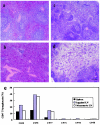Intravenous inoculation of replication-deficient recombinant vaccinia virus DIs expressing simian immunodeficiency virus gag controls highly pathogenic simian-human immunodeficiency virus in monkeys
- PMID: 14645581
- PMCID: PMC296093
- DOI: 10.1128/jvi.77.24.13248-13256.2003
Intravenous inoculation of replication-deficient recombinant vaccinia virus DIs expressing simian immunodeficiency virus gag controls highly pathogenic simian-human immunodeficiency virus in monkeys
Retraction in
-
Intravenous inoculation of replication-deficient recombinant vaccinia virus DIs expressing simian immunodeficiency virus gag controls highly pathogenic simian-human immunodeficiency virus in monkeys.J Virol. 2005 Mar;79(5):3229. doi: 10.1128/JVI.79.5.3229.2005. J Virol. 2005. PMID: 15709047 Free PMC article. No abstract available.
Abstract
To be effective, a vaccine against human immunodeficiency virus type 1 (HIV-1) must induce virus-specific T-cell responses and it must be safe for use in humans. To address these issues, we developed a recombinant vaccinia virus DIs vaccine (rDIsSIVGag), which is nonreplicative in mammalian cells and expresses the full-length gag gene of simian immunodeficiency virus (SIV). Intravenous inoculation of 10(6) PFU of rDIsSIVGag in cynomologus macaques induced significant levels of gamma interferon (IFN-gamma) spot-forming cells (SFC) specific for SIV Gag. Antigen-specific lymphocyte proliferative responses were also induced and were temporally associated with the peak of IFN-gamma SFC activity in each macaque. In contrast, macaques immunized with a vector control (rDIsLacZ) showed no significant induction of antigen-specific immune responses. After challenge with a highly pathogenic simian-human immunodeficiency virus (SHIV), CD4(+) T lymphocytes were maintained in the peripheral blood and lymphoid tissues of the immunized macaques. The viral set point in plasma was also reduced in these animals, which may be related to the enhancement of virus-specific intracellular IFN-gamma(+) CD8(+) cell numbers and increased antibody titers after SHIV challenge. These results demonstrate that recombinant DIs has potential for use as an HIV/AIDS vaccine.
Figures







Similar articles
-
Vaccination of Macaques with DNA Followed by Adenoviral Vectors Encoding Simian Immunodeficiency Virus (SIV) Gag Alone Delays Infection by Repeated Mucosal Challenge with SIV.J Virol. 2019 Oct 15;93(21):e00606-19. doi: 10.1128/JVI.00606-19. Print 2019 Nov 1. J Virol. 2019. PMID: 31413132 Free PMC article.
-
Replication-incompetent adenoviral vaccine vector elicits effective anti-immunodeficiency-virus immunity.Nature. 2002 Jan 17;415(6869):331-5. doi: 10.1038/415331a. Nature. 2002. PMID: 11797011
-
Multigene DNA priming-boosting vaccines protect macaques from acute CD4+-T-cell depletion after simian-human immunodeficiency virus SHIV89.6P mucosal challenge.J Virol. 2003 Nov;77(21):11563-77. doi: 10.1128/jvi.77.21.11563-11577.2003. J Virol. 2003. PMID: 14557642 Free PMC article.
-
Mechanisms of protection against simian immunodeficiency virus infection.Vaccine. 2002 May 6;20(15):1985-7. doi: 10.1016/s0264-410x(02)00083-x. Vaccine. 2002. PMID: 11983259 Review.
-
Virus replication and evolution drive the kinetics and specificity of SIV-specific cytotoxic T lymphocytes.Immunol Rev. 2001 Oct;183:109-14. doi: 10.1034/j.1600-065x.2001.1830109.x. Immunol Rev. 2001. PMID: 11782251 Review.
Cited by
-
Vaccination of rhesus macaques with recombinant Mycobacterium bovis bacillus Calmette-Guérin Env V3 elicits neutralizing antibody-mediated protection against simian-human immunodeficiency virus with a homologous but not a heterologous V3 motif.J Virol. 2005 Feb;79(3):1452-62. doi: 10.1128/JVI.79.3.1452-1462.2005. J Virol. 2005. PMID: 15650171 Free PMC article.
-
A consecutive priming-boosting vaccination of mice with simian immunodeficiency virus (SIV) gag/pol DNA and recombinant vaccinia virus strain DIs elicits effective anti-SIV immunity.J Virol. 2004 Sep;78(18):9842-53. doi: 10.1128/JVI.78.18.9842-9853.2004. J Virol. 2004. PMID: 15331719 Free PMC article.
References
-
- Allen, T. M., J. Sidney, M. F. del Guercio, R. L. Glickman, G. L. Lensmeyer, D. A. Wiebe, R. DeMars, C. D. Pauza, R. P. Johnson, A. Sette, and D. I. Watkins. 1998. Characterization of the peptide binding motif of a rhesus MHC class I molecule (Mamu-A*01) that binds an immunodominant CTL epitope from simian immunodeficiency virus. J. Immunol. 160:6062-6071. - PubMed
-
- Amara, R. R., F. Villinger, J. D. Altman, S. L. Lydy, S. P. O'Neil, S. I. Staprans, D. C. Montefiori, Y. Xu, J. G. Herndon, L. S. Wyatt, M. A. Candido, N. L. Kozyr, P. L. Earl, J. M. Smith, H. L. Ma, B. D. Grimm, M. L. Hulsey, J. Miller, H. M. McClure, J. M. McNicholl, B. Moss, and H. L. Robinson. 2001. Control of a mucosal challenge and prevention of AIDS by a multiprotein DNA/MVA vaccine. Science 292:69-74. - PubMed
-
- Amara, R. R., F. Villinger, S. I. Staprans, J. D. Altman, D. C. Montefiori, N. L. Kozyr, Y. Xu, L. S. Wyatt, P. L. Earl, J. G. Herndon, H. M. McClure, B. Moss, and H. L. Robinson. 2002. Different patterns of immune responses but similar control of a simian-human immunodeficiency virus 89.6P mucosal challenge by modified vaccinia virus Ankara (MVA) and DNA/MVA vaccines. J. Virol. 76:7625-7631. - PMC - PubMed
-
- Barouch, D. H., S. Santra, M. J. Kuroda, J. E. Schmitz, R. Plishka, A. Buckler-White, A. E. Gaitan, R. Zin, J. H. Nam, L. S. Wyatt, M. A. Lifton, C. E. Nickerson, B. Moss, D. C. Montefiori, V. M. Hirsch, and N. L. Letvin. 2001. Reduction of simian-human immunodeficiency virus 89.6P viremia in rhesus monkeys by recombinant modified vaccinia virus Ankara vaccination. J. Virol. 75:5151-5158. - PMC - PubMed
-
- Barouch, D. H., S. Santra, J. E. Schmitz, M. J. Kuroda, T. M. Fu, W. Wagner, M. Bilska, A. Craiu, X. X. Zheng, G. R. Krivulka, K. Beaudry, M. A. Lifton, C. E. Nickerson, W. L. Trigona, K. Punt, D. C. Freed, L. Guan, S. Dubey, D. Casimiro, A. Simon, M. E. Davies, M. Chastain, T. B. Strom, R. S. Gelman, D. C. Montefiori, M. G. Lewis, E. A. Emini, J. W. Shiver, and N. L. Letvin. 2000. Control of viremia and prevention of clinical AIDS in rhesus monkeys by cytokine-augmented DNA vaccination. Science 290:486-492. - PubMed
Publication types
MeSH terms
Substances
LinkOut - more resources
Full Text Sources
Medical
Research Materials

